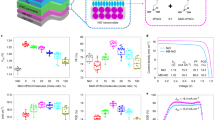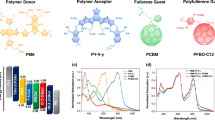Abstract
Dye-sensitized solar cells have established themselves as a potential low-cost alternative to conventional solar cells owing to their remarkably high power-conversion efficiency combined with ‘low-tech’ fabrication processes1,2. As a further advantage, the active layers consisting of nanoporous TiO2 are only some tens of micrometres thick and are therefore in principle suited for flexible applications. However, typical flexible plastic substrates cannot withstand the process temperatures of up to 500 ∘C commonly used for sintering the TiO2 nanoparticles together. Even though some promising routes for low-temperature sintering have been proposed3,4,5,6,7,8,9, those layers cannot compete as regards electrical properties with layers obtained with the standard high-temperature process. Here we show that by a lift-off technique, presintered porous layers can be transferred to an arbitrary second substrate, and the original electrical properties of the transferred porous layers are maintained. The transfer process is greatly assisted by the application of composite layers comprising nanoparticles and nanorods.
This is a preview of subscription content, access via your institution
Access options
Subscribe to this journal
Receive 12 print issues and online access
$259.00 per year
only $21.58 per issue
Buy this article
- Purchase on Springer Link
- Instant access to full article PDF
Prices may be subject to local taxes which are calculated during checkout





Similar content being viewed by others
References
O’Regan, B. & Grätzel, M. A low-cost, high-efficiency solar cell based on dye-sensitized colloidal TiO2 films. Nature 353, 737–739 (1991).
Grätzel, M. Photoelectrochemical cells. Nature 414, 338–344 (2001).
Lindström, H. et al. A new method for manufacturing nanostructured electrodes on plastic substrates. Nano Lett. 1, 97–100 (2001).
Lindström, H., Holmberg, A., Magnusson, E., Malmquist, L. & Hagfeldt, A. A new method to make dye-sensitized nanocrystalline solar cells at room temperature. J. Photochem. Photobiol. A 145, 107–112 (2001).
Boschloo, G., Lindström, H., Magnusson, E., Holmberg, A. & Hagfeldt, A. Optimization of dye-sensitized solar cells prepared by compression method. J. Photochem. Photobiol. A 148, 11–15 (2002).
Hague, S. A. et al. Flexible dye sensitised nanocrystalline semiconductor solar cells. Chem. Commun. 24, 3008–3009 (2003).
Zhang, D., Yoshida, T. & Minoura, H. Low-temperature fabrication of efficient porous titania photoelectrodes by hydrothermal crystallization at the solid/gas interface. Adv. Mater. 15, 814–817 (2003).
Pichot, F., Pitts, J. R. & Gregg, B. A. Low-temperature sintering of TiO2 colloids: application to flexible dye-sensitized solar cells. Langmuir 16, 5626–5630 (2000).
Kado, T., Yamaguchi, M., Yamada, Y. & Hayase, S. Low temperature preparation of nano-porous TiO2 layers for plastic dye sensitized solar cells. Chem. Lett. 32, 1056–1057 (2003).
Usami, A. Theoretical study of application of multiple scattering of light to a dye-sensitized nanocrystalline photoelectrochemical cell. Chem. Phys. Lett. 277, 105–108 (1997).
Barbé, C. J. et al. Nanocrystalline titanium oxide electrodes for photovoltaic applications. J. Am. Ceram. Soc. 80, 3157–3171 (1997).
Adachi, M., Okada, I., Ngamsinlapasathian, S., Murata, Y. & Yoshikawa, S. Dye-sensitized solar cells using semiconductor thin film composed of titania nanotubes. Electrochemistry 70, 449–452 (2002).
Sugimoto, T., Zhou, X. & Muramatsu, A. Synthesis of uniform anatase TiO2 nanoparticles by gel–sol method: 4. Shape control. J. Colloid Interface Sci. 259, 53–61 (2003).
Meyer, R. J. & Pietsch, E. H. E. (eds) Gmelins Handbuch der Anorganischen Chemie Vol. 41 238–243 (Verlag Chemie, Weinheim/Bergstrasse, 1951).
Schrauf, A. Ueber die Trimorphie und die Ausdehnungscoefficienten von Titandioxid. Z. Krystallogr. 9, 433–485 (1884).
Dürr, M., Bamedi, A., Yasuda, A. & Nelles, G. Tandem dye-sensitized solar cell for improved power conversion efficiency. Appl. Phys. Lett. 84, 3397–3399 (2004).
Wang, P. et al. A stable quasi-solid-state dye-sensitized solar cell with an amphiphilic ruthenium sensitizer and polymer gel electrolyte. Nature Mater. 2, 402–407 (2003).
Dürr, M. et al. Diffusion limited transport of I3− through nanoporous TiO2-polymer gel networks. J. Chem. Phys. 121, 11374–11378 (2004).
Kron, G. et al. Diffusion limitations to I3−/I− electrolyte transport through nanoporous TiO2 networks. Electrochem. Solid State Lett. 6, E11–E14 (2003).
Gao, Y. & Elder, S. A. TEM study of TiO2 nanocrystals with different particle size and shape. Mater. Lett. 44, 228–232 (2000).
Acknowledgements
The authors would like to thank K. Noda, Y. Suzuki and M. Morooka for discussions and A. Roberts for proofreading the manuscript.
Author information
Authors and Affiliations
Corresponding authors
Ethics declarations
Competing interests
The authors declare no competing financial interests.
Supplementary information
Supplementary Information
Supplementary materials and supplementary figures S1 - S5 (PDF 124 kb)
Rights and permissions
About this article
Cite this article
Dürr, M., Schmid, A., Obermaier, M. et al. Low-temperature fabrication of dye-sensitized solar cells by transfer of composite porous layers. Nature Mater 4, 607–611 (2005). https://doi.org/10.1038/nmat1433
Received:
Accepted:
Published:
Issue Date:
DOI: https://doi.org/10.1038/nmat1433
This article is cited by
-
TiO2 blocking layer incorporated TiO2/In2O3-based photoanode for DSSC application
Journal of Materials Science: Materials in Electronics (2023)
-
Cost effective dye sensitized solar cell based on novel Cu polypyrrole multiwall carbon nanotubes nanocomposites counter electrode
Scientific Reports (2021)
-
Effect of Ultraviolet Radiation on the Long-Term Stability of Dye-Sensitized Solar Cells
Electronic Materials Letters (2020)
-
Flexible, biodegradable and recyclable solar cells: a review
Journal of Materials Science: Materials in Electronics (2019)
-
N-doped TiO2 applied in low-temperature-based dye-sensitized solar cells
Research on Chemical Intermediates (2016)



